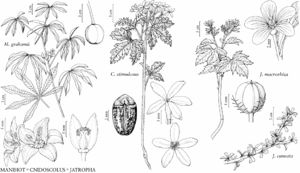Jatropha
Sp. Pl. 2: 1006. 1753.
Herbs, subshrubs, shrubs, or trees, perennial, monoecious or dioecious [gynodioecious]; hairs unbranched, sometimes glandular, or absent; latex colorless, cloudy-whitish, yellow, or red. Leaves deciduous or persistent, alternate but sometimes appearing fascicled, simple; stipules absent or present, persistent or deciduous; petiole absent or present, glands absent at apex, sometimes stipitate-glandular along length; blade unlobed or palmately lobed, margins entire, serrate, or dentate, laminar glands absent; venation pinnate or palmate. Inflorescences unisexual or bisexual (pistillate flowers central, staminate lateral), axillary or terminal, cymes or fascicles, or flowers solitary; glands subtending each bract 0. Pedicels present. Staminate flowers: sepals 5, imbricate, distinct or connate to 1/2 length; petals 5, distinct or connate basally to most of length, white, greenish yellow, pink, red, or purple [yellow, yellowbrown, orange, or 2-colored]; nectary extrastaminal, annular and 5-lobed or of 5 glands; stamens [6–] 8 or 10 in 1–2 whorls, distinct or connate basally to most of length; pistillode absent. Pistillate flowers: sepals 5, imbricate, distinct or connate to 1/2 length; petals 5, distinct or connate basally to most of length, white, greenish yellow, pink, red, or purple [yellow, yellowbrown, orange, or 2-colored]; nectary annular and 5-lobed or 5 glands; staminodes sometimes present; pistil 1–3-carpellate; styles (1–) 3, distinct or connate basally to most of length [absent], 2-fid. Fruits capsules, ± fleshy, sometimes tardily dehiscent. Seeds ellipsoid to globose; caruncle present (sometimes rudimentary) or absent. x = 11.
Distribution
s United States, Mexico, West Indies, Central America, South America, s Asia (India), Africa, elsewhere in Asia, Pacific Islands, Australia, tropical and subtropical regions
Discussion
Species ca. 190 (10 in the flora).
Some species of Jatropha are cultivated as ornamentals throughout the tropical and subtropical regions of the world, notably J. integerrima, J. multifida, and J. podagrica Hooker. These and J. curcas Linnaeus and J. gossypiifolia Linnaeus have escaped from cultivation in subtropical regions. Jatropha curcas (physic nut), which probably originated in Central America, is now pantropical and is extensively cultivated for production of biodiesel from its seeds, which are also eaten as roasted nuts and used as a purgative and for other medicinal purposes. More than 50 New World species are known from cultivation in the United States, either as ornamentals or for medicinal purposes, many of which are being studied. Some African species are in cultivation, primarily by collectors of succulent plants.
Selected References
Lower Taxa
Key
| 1 | Perennial herbs or rhizomatous subshrubs to 1 m; stems herbaceous or rubbery-succulent. | > 2 |
| 2 | Perennial herbs with subterranean caudices, to 0.5 m; stems green; plants monoecious; carpels 3. | > 3 |
| 3 | Caudices woody, stem scars crescent-shaped; leaf blades lobed nearly to base; corollas deep red; stamens distinct at maturity; Texas. | Jatropha cathartica |
| 3 | Caudices ± fleshy, stem scars round; leaf blades lobed to middle; corollas light pink; stamens: outer 5 distinct, inner 3 connate to 1/2 length; Arizona, New Mexico, Texas. | Jatropha macrorhiza |
| 2 | Rhizomatous subshrubs 0.5–1 m; stems reddish brown; plants dioecious; carpel 1. | > 4 |
| 4 | Petioles 1–2.5 cm; leaf blades widely ovate-deltate, 1.5–2.6 cm wide, unlobed, margins sinuate to weakly serrate-crenate; Arizona. | Jatropha cardiophylla |
| 4 | Petioles 0–0.2 cm; leaf blades linear-spatulate to narrowly obovate, 0.2–0.7 cm wide, sometimes 3-lobed, margins entire; Texas. | Jatropha dioica |
| 1 | Shrubs or trees, 1–10 m; stems woody or woody-succulent. | > 5 |
| 5 | Short shoots present; plants dioecious; corollas usually white, sometimes pinkish, petals connate 1/2+ length; Arizona. | > 6 |
| 6 | Latex cloudy-whitish; leaves mostly ± evenly distributed on long shoots, few on short shoots, petioles 1.3–3 cm, blades cordate to broadly ovate, 2.2–3.5 × 1.6–3 cm, canescent abaxially, sparingly hairy adaxially; corollas subglobose-urceolate; carpels 2. | Jatropha canescens |
| 6 | Latex yellow in young shoots, red in older shoots; leaves usually fascicled on short shoots, petioles 0(–0.2) cm, blades obovate-spatulate, 0.7–1.9 × 0.3–0.9 cm, glabrous; corollas tubular-urceolate; carpel 1. | Jatropha cuneata |
| 5 | Short shoots absent; plants monoecious; corollas greenish yellow, pink, red, orange, or purple, petals distinct or connate to 1/2 length; Florida. | > 7 |
| 7 | Stipules persistent, filiform-divided; stamens 8; styles distinct or connate to 1/4 length. | > 8 |
| 8 | Stipules, petioles, and/or leaf margins glandular; leaf blade 3–5-lobed; petals connate 1/4–1/2 length. | Jatropha gossypiifolia |
| 8 | Stipules, petioles, and leaf margins not glandular; leaf blade 9–11-lobed; petals distinct. | Jatropha multifida |
| 7 | Stipules caducous (narrowly lanceolate) or absent; stamens 10; styles connate 1/2+ length. | > 9 |
| 9 | Shrubs 2.5–5 m; corollas rotate, bright red to scarlet or pink; capsules explosively dehiscent. | Jatropha integerrima |
| 9 | Trees to 10 m; corollas campanulate, greenish yellow; capsules drupaceous. | Jatropha curcas |
"/2" is not declared as a valid unit of measurement for this property."connate" is not a number. "distinct" is not a number.

